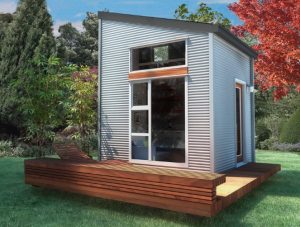Back in 2012, IKEA heralded a major shift in the construction market by introducing the world’s first, flat-pack structure to the mass market. Initially available for $86,500, this was the first of several designs that presented sustainable, fabricated structures as a viable solution to the growing housing crisis.
Since then, we have seen increased diversification in the housing market and gradual shift in the buying habits of consumers. This is reflected by a sizeable increase in the sale of motorhomes throughout the UK, while the rising demand for fabricated and manufactured homes also draws to attention to a changeable and constantly evolving housing market.
 Image: – Inhabitat
Image: – Inhabitat
How to Make the Most of Your Fabricated Home Interior
Of course, some will argue that the rising demand for alternative types of housing has been triggered primarily by a fundamental lack of supply. While this has played a part, there is no doubt that aspiring, contemporary buyers are increasingly drawn to the comparative advantages of alternative structures (including benefits relating to cost, sustainability and flexibility).
Regardless of which type of alternative housing your invest in (and whether you buy a flat-pack structure or purchase a pre-made, fabricated home), however, the question that remains is how to optimise the interior in a way that optimises the available space and enables you to infuse your own, unique personality.
With this in mind, here are three options to help you achieve this goal: –
Focus on the Finishing Touches
There is an old Chinese proverb which suggests that even when you have completed 90% of a specific project, you are only half-way towards achieving your goal. This is best embodied by home construction and remodelling projects, in which finishing each room and creating a desired aesthetic accounts for large amounts of time and money.
The importance of the finish is even more important in alternative and fabricated homes, as these often boast a uniform and universal layouts that must be customised if you are make them unique. Similarly, these structures can also be relatively compact, depending on price and the amount of land that you have on which to build the house.
With these factors in mind, your primary goal should be to introduce homely, finishing touches that add elements of warmth and comfort. This is similar to the approach that you would adopt when personalising a rental space, as you focus on introducing a focal point fireplace, creative storage solutions and warm colours to bring the existing space to life.
Leverage the Structures’ Natural Advantages
It is also important to leverage the natural advantages pertaining to manufactured and flat-pack homes, as these can have a huge impact on the quality of the finish. Due to the economic use of materials, for example, these structures tend to have large window spaces which allow a tremendous amount of natural light to engulf the interior space.
To capitalise on this, you should focus on adopting a minimalist design ethos (wherever possible) and integrating natural, wooden furniture as a core design element. This will not only help to optimise the sense of space and light, but will also accentuate the natural levels of illumination and create an organic sense of warmth.
Bring the Outside In
One of the most striking advantages of flat-pack and manufactured homes is that they are naturally sustainable in terms of material usage and their functionality. This instantly creates an environmental design ethos, and one that can be continued throughout the finish and interior layout of the property.
One of the best examples lies with the fusion of interior and exterior design influences, which extends the space and creates a natural link between the home and any garden space that you have. There are several ways that you can achieve this, such as building a living ‘feature’ wall or simply increasing the amount of flowers and plants that are included throughout the property.
The key is to make decision decisions in line with the space and budget at your disposal, while also focusing on the unique elements that made you selected an alternative type of housing in the first place.
